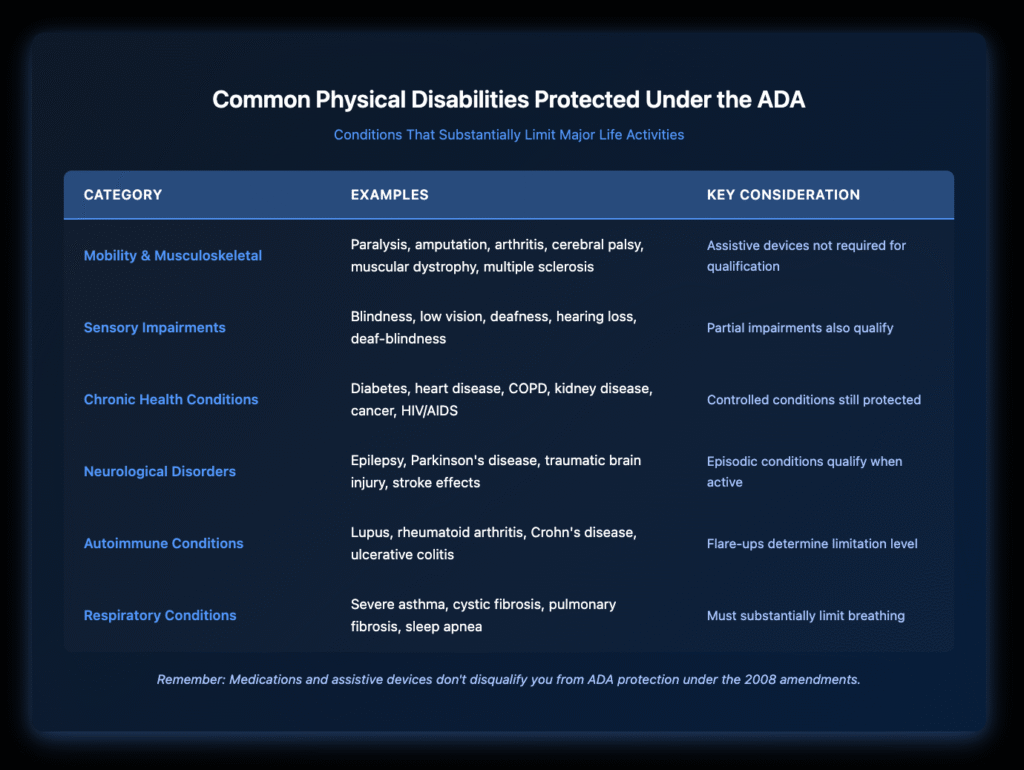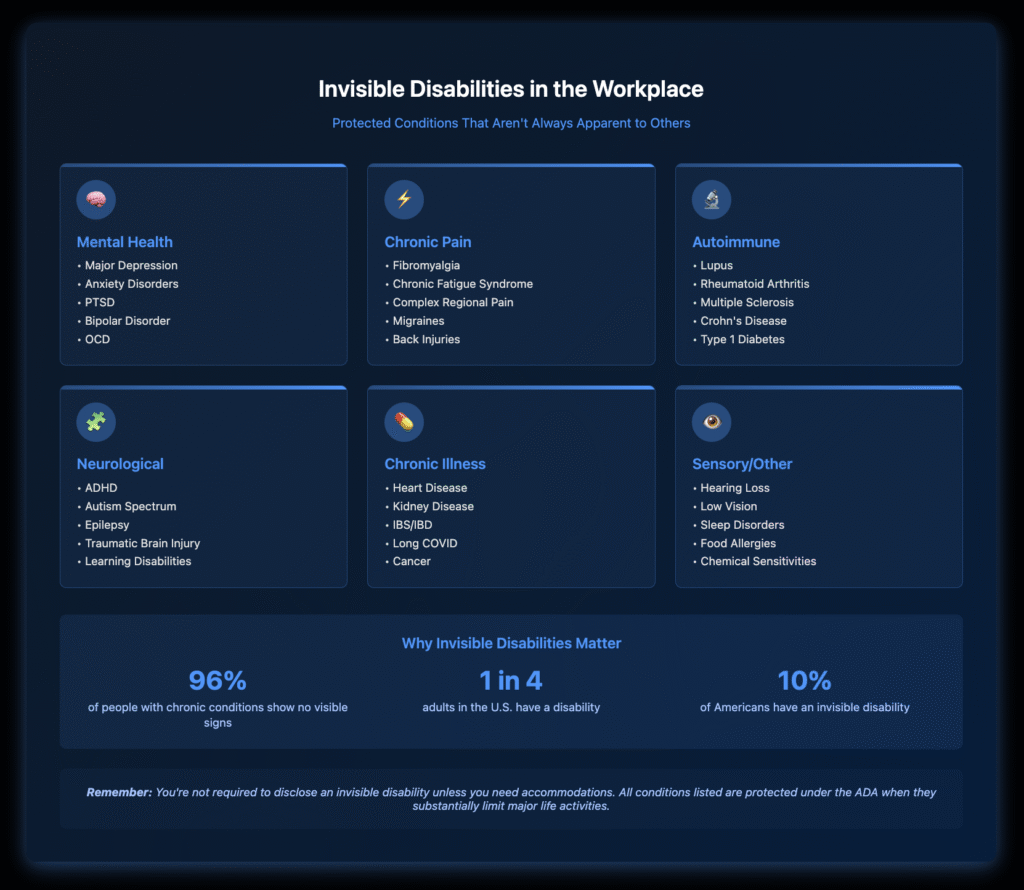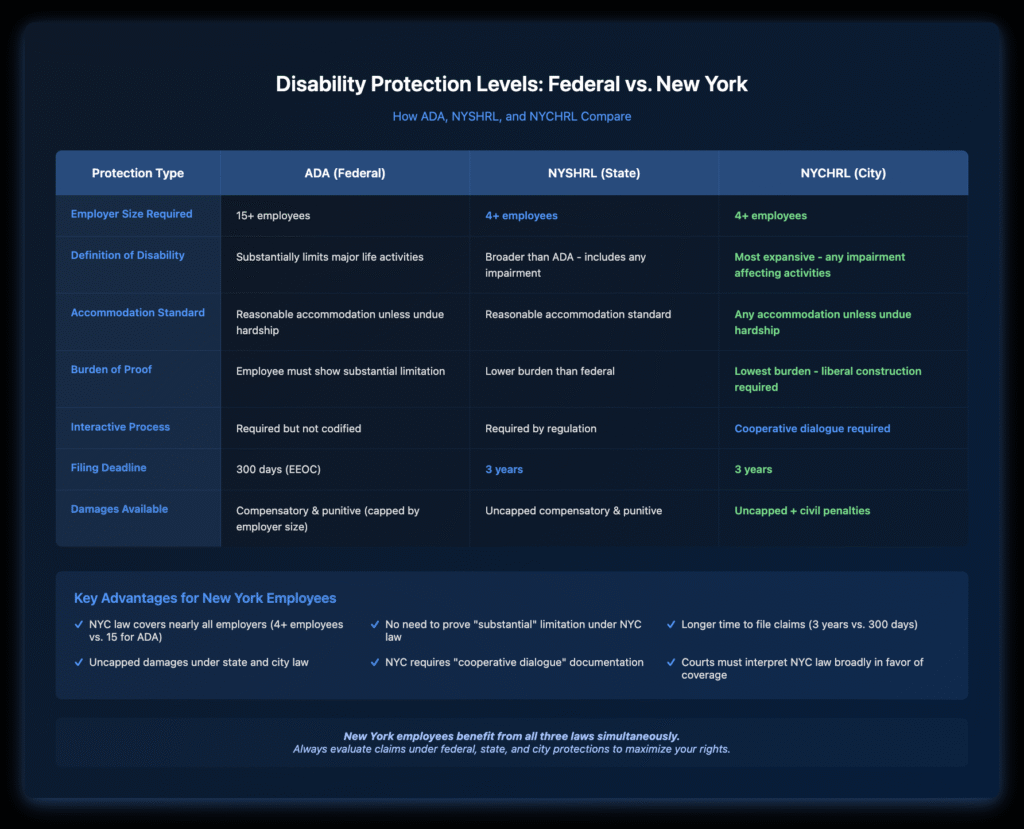You qualify for ADA protection if you have a physical or mental impairment that substantially limits one or more major life activities, have a record of such an impairment, or your employer treats you as having a disability—even if you don’t actually have one. The Americans with Disabilities Act defines disability broadly to include conditions like mobility impairments, chronic illnesses, mental health conditions, and invisible disabilities such as diabetes, epilepsy, depression, and long COVID. In New York, state and city laws provide even broader protections, covering more employees and conditions than federal law requires.
Key Takeaways
- The ADA uses a three-part definition: actual disability, record of disability, or being regarded as having a disability
- Physical and mental conditions both qualify when they substantially limit major life activities
- “Substantially limits” means significantly restricted compared to the average person—not completely prevented
- Invisible disabilities like chronic pain, mental health conditions, and autoimmune diseases receive full protection
- The 2008 ADA Amendments Act expanded coverage by including episodic conditions and major bodily functions
- Mitigating measures like medication don’t disqualify you from ADA protection
- New York State and NYC laws offer even stronger disability protections than federal law
Disclaimer: This article provides general information for informational purposes only and should not be considered a substitute for legal advice. It is essential to consult with an experienced employment lawyer at our law firm to discuss the specific facts of your case and understand your legal rights and options. This information does not create an attorney-client relationship.
What Are the Three Ways to Qualify for ADA Protection?
The ADA recognizes that disability discrimination takes many forms. That’s why the law provides three distinct paths to protection, ensuring coverage for people with current disabilities, those with past conditions, and even those wrongly perceived as disabled.
How Does Having an “Actual Disability” Qualify You?
An actual disability exists when your physical or mental impairment substantially limits one or more major life activities. Major life activities include everyday functions like walking, seeing, hearing, speaking, breathing, learning, and concentrating. They also encompass major bodily functions—your immune system, digestive system, neurological functions, and circulatory system all count.
The key phrase “substantially limits” doesn’t mean you’re completely unable to perform these activities. It means you’re significantly restricted compared to most people in the general population. For instance, someone with multiple sclerosis might qualify even with intermittent symptoms—during flare-ups, their walking, concentration, and stamina become substantially limited.
What If You Have a History of Disability?
You’re protected under the “record of disability” provision if you’ve had a substantially limiting impairment in the past. This protection exists whether or not you currently experience limitations. Cancer survivors in remission qualify here, as do people with controlled epilepsy or past mental health hospitalizations.
This provision prevents discrimination based on medical history. Employers can’t refuse to hire or promote you because they fear your condition might return or because they hold stereotypes about your past health challenges.
Can You Be Protected If Your Employer Just Thinks You’re Disabled?
The “regarded as” provision protects you when an employer treats you as having a disability, regardless of whether you actually have one. If your manager denies you a promotion because they incorrectly believe your psoriasis is contagious, or if they assume your slight limp means you can’t perform certain tasks, you’re protected under this category.
This third category combats discrimination based on myths, fears, and stereotypes about disability. You don’t need to prove actual limitations—just that your employer took adverse action based on a perceived impairment.
Which Physical Conditions Qualify as Disabilities?
Physical disabilities under the ADA span a wide range of conditions affecting your body’s systems and functions. Understanding which conditions typically qualify helps you recognize when you have protected rights.

Do Mobility and Musculoskeletal Conditions Qualify?
Mobility impairments—whether you use a wheelchair, walker, cane, or prosthetic—clearly qualify when they substantially limit walking or moving. But you don’t need assistive devices to qualify. Severe arthritis, back injuries causing chronic pain, or conditions affecting your joints and muscles can all constitute disabilities when they significantly restrict your daily activities.
Remember that permanent conditions aren’t the only ones protected. A leg injury with lasting effects qualifies, while a sprained ankle healing in weeks typically doesn’t.
What About Chronic Health Conditions?
Chronic conditions often qualify as disabilities, especially when they affect major bodily functions. Diabetes affects your endocrine system, making it a covered disability even when controlled by insulin. Heart disease, COPD, asthma, and other respiratory conditions qualify when they substantially limit breathing or circulatory functions.
Autoimmune conditions like lupus, rheumatoid arthritis, and Crohn’s disease receive protection. HIV/AIDS qualifies due to its impact on the immune system. Even conditions with periodic flare-ups count—you’re evaluated based on your limitations when the condition is active.
How Do Mental Health Conditions Qualify Under the ADA?
Mental health conditions receive the same protection as physical disabilities when they substantially limit major life activities. These activities include concentrating, thinking, communicating, and interacting with others.
Which Mental Health Diagnoses Are Commonly Protected?
Major depression, anxiety disorders, PTSD, bipolar disorder, schizophrenia, and obsessive-compulsive disorder frequently qualify for ADA protection. ADHD qualifies when it substantially limits concentration or executive function. Autism spectrum disorders receive protection based on their impact on communication and social interaction.
The severity and impact matter more than the specific diagnosis. Your condition must substantially limit major life activities—but remember, treatment doesn’t disqualify you. Even if medication helps manage your symptoms, you still have ADA protection.
What Makes Invisible Disabilities Different?
Invisible disabilities—conditions not immediately apparent to others—face unique workplace challenges. Colleagues might question their legitimacy, and you must decide whether disclosing your condition is worth potential stigma.
What Counts as an Invisible Disability?
Fibromyalgia, chronic fatigue syndrome, and other chronic pain conditions qualify despite being invisible. Migraine disorders that substantially limit concentration or require frequent absences receive protection. Learning disabilities like dyslexia count when they affect reading, processing, or communication.
Mental health conditions typically fall into this category. So do many autoimmune diseases, digestive disorders like IBS or Crohn’s disease, and neurological conditions in their early stages.

Should You Disclose an Invisible Disability?
You’re not required to disclose unless you need accommodations. Without disclosure, though, your employer has no obligation to accommodate your needs. Consider these factors: Will accommodations significantly improve your performance? Can you document your condition if questioned? Are you prepared to educate others about your invisible disability?
How Did the ADA Amendments Act Expand Coverage?
The 2008 ADA Amendments Act (ADAAA) dramatically broadened disability coverage after Supreme Court decisions had narrowed it. These changes ensure more people receive the protection Congress originally intended.
What Changed About “Major Life Activities”?
The ADAAA expanded the list to explicitly include major bodily functions—immune, digestive, neurological, respiratory, circulatory, and endocrine systems now clearly count. It added activities like reading, concentrating, thinking, and communicating to the protected list.
Episodic conditions now qualify based on limitations when active. Epilepsy, multiple sclerosis, and mental health conditions with periodic symptoms receive protection even during remission.
Why Don’t Medications Disqualify You Anymore?
The ADAAA’s most significant change: mitigating measures don’t factor into determining disability. Your diabetes qualifies even if insulin controls it perfectly. Depression counts despite medication managing symptoms. Hearing aids, prosthetics, and assistive technology don’t disqualify you.
Only ordinary eyeglasses and contact lenses count as mitigating measures that might disqualify a condition. Everything else—medication, medical devices, behavioral adaptations—gets ignored when determining disability status.
When Might Your Condition NOT Qualify?
Not every health condition meets the ADA’s definition. Understanding these limitations helps set realistic expectations about your rights.
What Conditions Are Too Minor or Temporary?
Common colds, minor sprains, and brief illnesses don’t qualify—they’re temporary with no lasting impact. Mild seasonal allergies that barely affect daily life won’t meet the threshold. Broken bones that heal normally within expected timeframes typically don’t qualify unless complications create lasting limitations.
The key question: Does your condition substantially limit major life activities for more than a few months? Short-term conditions rarely qualify unless they cause long-term complications.
Are Any Conditions Specifically Excluded?
The ADA explicitly excludes current illegal drug use, though addiction recovery receives protection. Certain behavioral conditions like kleptomania, pyromania, and compulsive gambling don’t qualify. Sexual behavior disorders and gender identity disorders were historically excluded, though recent court decisions have begun recognizing gender dysphoria as protected.
How Do New York Laws Provide Additional Protection?
New York State Human Rights Law and New York City Human Rights Law offer broader disability protections than federal law. These differences can significantly impact your rights as a New York employee.
What Makes NYC’s Definition More Inclusive?
New York City uses the most expansive disability definition in the nation. While the ADA requires “substantial” limitation, NYC law protects any impairment that limits activities to any extent. The city law covers employers with just four employees, compared to the ADA’s 15-employee threshold.
NYC employers must provide any accommodation unless it causes undue hardship—a higher standard than the ADA’s “reasonable” accommodation requirement.

What Should You Do If You Think You Qualify?
Taking the right steps protects your rights and strengthens any potential claims. Start by reviewing your employee handbook’s accommodation procedures—most companies outline the process there.
Document how your condition limits major life activities. Focus on specific impacts: “My arthritis prevents me from typing for more than 20 minutes without breaks” works better than just naming your diagnosis.
Consider what accommodations would help you succeed. Would flexible scheduling address fatigue from your condition? Would ergonomic equipment reduce physical strain? Think practically about solutions.
Initiate the interactive process by informing HR or your supervisor about your disability and accommodation needs. Be prepared for back-and-forth discussion about effective options. Document every conversation, email, and meeting about your disability and accommodation requests.
When Should You Contact an Employment Attorney?
If your employer questions whether your condition qualifies or refuses reasonable accommodations, legal guidance becomes crucial. Disability determination can be complex, especially for invisible or mental health conditions.
An experienced employment attorney can evaluate whether your condition qualifies under federal, state, and city laws. They’ll help document your disability effectively, guide you through the accommodation process, and address any discrimination or retaliation you face.
At Nisar Law, our employment attorneys specialize in disability discrimination cases throughout New York. Whether you’re facing accommodation denials, harassment based on your condition, or wrongful termination, we’ll protect your rights and pursue appropriate remedies.
Understanding your rights under disability law is the first step toward securing workplace equality. Contact Nisar Law today for a confidential consultation about your disability discrimination concerns. We’ll help you navigate the complex intersection of federal, state, and city protections to achieve the best possible outcome.
Related Resources
- Reasonable Accommodations: What to Request and How
- Medical Examinations and Inquiries: Employee Rights
- Mental Health Disabilities: Special Considerations
- Invisible Disabilities in the Workplace
- Proving Disability Discrimination: Building Your Case
- Workplace Disability Discrimination: Your Complete Legal Guide
- When Employers Can Claim “Undue Hardship”
- Disability Discrimination in Remote Work Environments
- Long COVID as a Disability: Emerging Legal Considerations
Frequently Asked Questions About ADA Disability Protections
The ADA recognizes any physical or mental impairment that substantially limits one or more major life activities. This includes visible conditions like paralysis, blindness, and mobility impairments, as well as invisible conditions like diabetes, epilepsy, depression, anxiety disorders, PTSD, and chronic pain conditions. The law also protects you if you have a history of such an impairment (like cancer in remission) or if your employer perceives you as having a disability, even if you don’t. Since the 2008 amendments, the definition is interpreted broadly—conditions that are episodic or in remission qualify when active, and medications or assistive devices don’t disqualify you from protection.
Yes, anxiety disorders can absolutely qualify for ADA protection when they substantially limit major life activities like concentrating, thinking, communicating, or interacting with others. You don’t need to be completely unable to function—if your anxiety significantly restricts these activities compared to most people, you’re protected. Even if medication helps manage your symptoms, you still qualify. The key is documenting how anxiety affects your daily life and work performance. In New York City, the bar is even lower—any mental health condition that affects your activities to any extent receives protection.
The ADA doesn’t cover temporary conditions with no lasting impact, like common colds, minor sprains that heal normally, or brief stomach bugs. Current illegal drug use is explicitly excluded, though addiction recovery is protected. Conditions that have minimal impact on major life activities—like mild seasonal allergies or minor vision problems corrected by ordinary eyeglasses—typically don’t qualify. The ADA also specifically excludes certain behavioral conditions like kleptomania, pyromania, and compulsive gambling. However, the threshold is lower than many realize—if you’re unsure whether your condition qualifies, it’s worth consulting an attorney, especially in New York where state and city laws are more inclusive.
To prove disability under the ADA, focus on documenting how your condition substantially limits major life activities rather than just naming your diagnosis. Get medical documentation that specifically addresses these limitations—for example, how your condition affects walking, concentrating, or performing manual tasks. Keep records of symptoms, flare-ups, and how they impact your daily activities. When requesting accommodations, connect your limitations directly to specific job functions and proposed solutions. You don’t need to prove you’re completely unable to work—just that you’re significantly restricted compared to most people. Remember, in New York City, the burden of proof is much lower, and courts must interpret the law in your favor.
IBS (Irritable Bowel Syndrome) can qualify as a disability under the ADA when it substantially limits major life activities or major bodily functions like digestive and bowel functions. Severe IBS that causes frequent, unpredictable flare-ups requiring immediate bathroom access, or that significantly restricts your diet and daily activities, often qualifies. The key is demonstrating how IBS impacts your ability to work, concentrate, or maintain regular attendance. Document your symptoms, medical treatment, and specific limitations. Many employees with IBS successfully obtain accommodations like flexible scheduling, work-from-home options, or workstations near restrooms.
You’ll need medical documentation from your healthcare provider that describes your impairment and how it limits major life activities—not just a diagnosis. This should include: specific functional limitations (like “cannot sit for more than 30 minutes” rather than just “back pain”), the expected duration of limitations, and how your condition affects job-related activities. You don’t need to provide your entire medical history—employers can only request information relevant to your accommodation request and functional limitations. Keep your own records of symptoms, flare-ups, and work impacts. In the interactive process, you might need to provide updated documentation if your condition or needs change.
Yes, the ADA prohibits employers from firing you because of your disability or because you requested reasonable accommodations. You can’t be terminated for needing accommodations, taking protected medical leave, or because your employer fears or assumes things about your condition. However, you must still be able to perform essential job functions with or without reasonable accommodations. If you’re fired after disclosing a disability or requesting accommodations, document everything—this timing can be evidence of discrimination. In New York, you have even stronger protections and three years to file a claim instead of the federal 300-day deadline. If you believe you’ve been wrongfully terminated due to your disability, contact an employment attorney immediately to preserve your rights.
Invisible disabilities like fibromyalgia, chronic fatigue syndrome, and mental health conditions can be more challenging to prove because others can’t see your limitations. Conditions with unpredictable symptoms or flare-ups—like migraines, autoimmune diseases, or PTSD—require careful documentation of episodes and their impact. Learning disabilities and cognitive impairments may need specialized testing to document. The challenge isn’t that these conditions don’t qualify, but that you need thorough documentation showing how they substantially limit major life activities. Working with healthcare providers who understand ADA requirements and keeping detailed records of symptoms and limitations strengthens your case. Remember, under New York City law, the standard is much easier to meet—any impairment affecting your activities qualifies.


